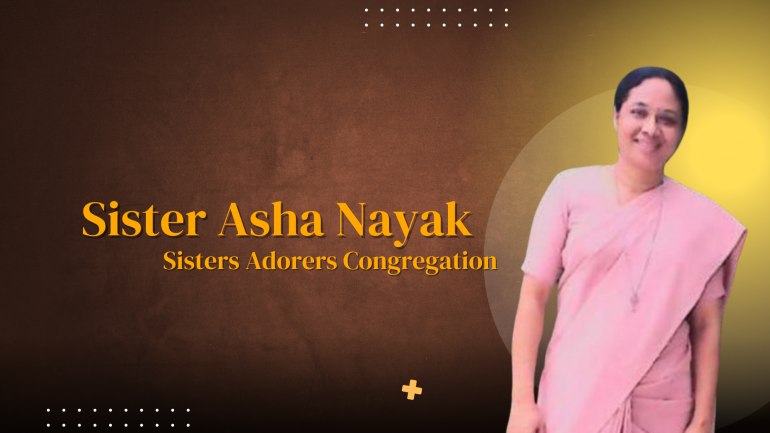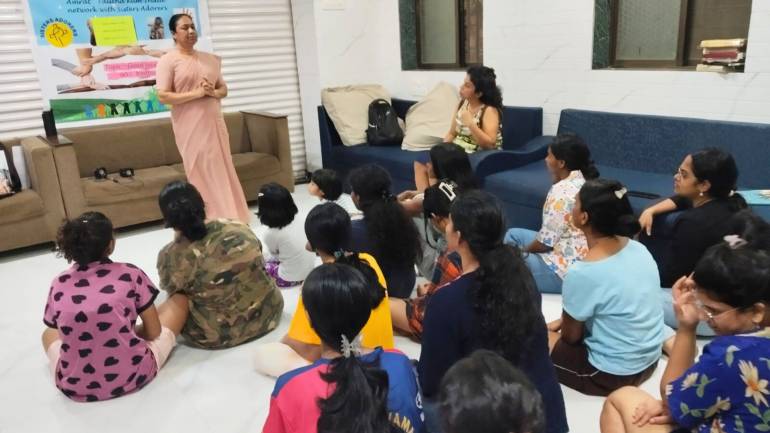A Nun Among the Forgotten: Sister Asha’s Mission of Compassion in Mumbai’s Red-Light District

For the past twelve years, Sister Asha Nayak, a Catholic nun of the Sisters Adorers Congregation, has made her home and mission in the heart of Mumbai’s red-light area, not to preach or convert, but to heal, restore, and bring dignity to those society has cast aside.
“I was sent here, perhaps by accident,” she says with a quiet laugh. Then, after a pause, she adds, “But maybe it wasn’t an accident at all. Maybe this is where I was called to be.”
Born into a peasant family in Kerubadi, a small mission station in Odisha’s Kandhamal district, Sister Asha grew up in the Archdiocese of Cuttack-Bhubaneswar, where her parish recently marked 110 years of Christianity. She joined the Sisters Adorers in 1995, made her first profession in 1999, and her final profession in 2005.
Her ministry began in Goa’s Baina red-light district in 2011 and later extended to Mumbai’s infamous neighborhoods of Turbhe, Ghatkopar, Grant Road, and Kamathipura, Asia’s largest and oldest red-light district. Working in collaboration with government bodies and NGOs, her mission has always been simple: to accompany, uplift, and restore the dignity of women trapped in cycles of exploitation.
“When I first arrived, I was shocked and heartbroken,” she recalls. “But behind every locked door was a story, of poverty, betrayal, and survival. I couldn’t turn away.”
What started as occasional visits soon evolved into a full-time mission of compassion. In the cramped lanes between brothels, she established a small community center, brightly painted rooms echoing with laughter, the hum of sewing machines, and the chatter of children learning their first alphabets. Here, women learn tailoring, embroidery, and other skills that might one day help them step away from sex work. Their children, under the guidance of volunteer teachers, take their first steps toward education and a future beyond the brothels.
“They call me badi behen, Didi, elder sister,” she says with a gentle smile. “Many just come to talk, to be heard. Sometimes, that’s all the healing they need.”

At first, her presence was met with suspicion and resistance. Brothel owners feared she might bring unwanted attention.
“She doesn’t judge us,” says Reena (name changed), a sex worker in her thirties. “When my daughter is upset, Sister Asha comforts her like a mother. She brings peace.”
Each day for Sister Asha begins with prayer, but her true ministry unfolds outside the convent walls—cleaning wounds, teaching English, listening to the broken-hearted, and tending to those forgotten by society. She never asks anyone about religion.
“You are a beautiful creation of God,” she often tells them. “He is present in every act of kindness, in every child who dares to dream.”
Over the years, many women touched by her work have rebuilt their lives—some now run small tailoring shops, others work with local NGOs or in community programs. Yet, Sister Asha insists she has gained more than she has given.
“I haven’t changed this place,” she says softly. “It has changed me. It has taught me that compassion means serving without expecting anything in return.”
For the Sisters Adorers, whose charism blends adoration and liberation, the strength to serve flows from the Eucharist. “We draw our energy from Christ’s love,” says Sister Asha. “From the altar, we go forth to free those enslaved by exploitation and despair.”
In the dark alleys of Kamathipura, where hope often flickers faintly, the quiet presence of one nun continues to remind the forgotten that they, too, are seen, loved, and worthy of dignity.
(Fr. Purushottam Nayak is an Indian Catholic priest who contributes to various magazines and online platforms.)
Let us know how you feel!
Comments
Aber es bleibt eine schwere sexuelle Sucht, wenn Männer zu Prostituierten gehen müssen.
Eigentlich muss vor allem für diese Männer Seelsorge zur Verfügung gestellt werden, damit sie erkennen lernen, wie grausam sie sich selbst am schaden sind.
Sie müssen darüber nachdenken lernen, warum der Apostel Paulus im 1. BRIEF an die Korinther, Kapitel 6. gesagt hat, dass die sexuelle Sünde wie keine andere, IN DEN KÖRPER hinein gelangt.
Ausserdem sollten gerade diese Männer, die zu Prostituierten gehen mit der THEOLOGIE DES LEIBES bekannt gemacht werden.
Wie viel mehr seelische Kraft hätten diese armen Männer, wenn sie auf diese Form der Sexualität verzichten würden und statt dessen überlegen könnten, wie sie den Frauen bessere Arbeitsplätze schaffen könnten.
Gleichzeitig müssen schon in jungen Jahren die Söhne mit der Theologie des Leibes vertraut gemacht werden, damit sie lernen, sexuell keuch bis zu ihrer Ehe mit nur EINEN FRAU zu leben.
Wenn wir dieses Thema also global tiefer heilen lernen wollen, dann müssen wir uns dich noch stärker der Bibel und JESUS selbst anvertrauen lernen.
Nicht nur in Indien, sondern weltweit.
Gottes Segen uns allen !!!










- Reply
Permalink